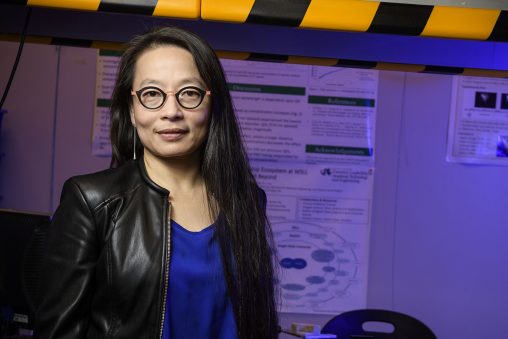
A startup company founded by Caroline Cao, professor in the Wright State College of Engineering and Computer Science and Boonshoft School of Medicine, hopes to commercialize a radiation-free alternative to X-ray imaging during minimally invasive surgery.
A startup company founded by Wright State University professor Caroline Cao has been awarded $150,000 in state funding to develop and commercialize a radiation-free alternative to X-ray imaging during minimally invasive surgery.
Cao, professor of biomedical, industrial and human factors engineering in the College of Engineering and Computer Science, is founder of Endo Guidance Technologies, a Dayton startup company.
Endovascular surgery is a minimally invasive approach to treat cardiovascular diseases such as plaque buildup in vessels or aneurysms. Surgeons must insert guidewires and catheters into the patient’s blood vessels. This is done blind, guided only by fluoroscopy (X-ray imaging) when needed.
Recovery time for the patients is much faster, with lower rates of infection and decreased pain and suffering.
Cao headed a team of researchers who invented a revolutionary medical device that could eliminate the need for radiation-emitting X-rays in the image-guided minimally invasive surgical procedures.
She is working on the prototype of a lightweight sensor and display that would help guide surgeons in endovascular surgery — similar to a GPS for endovascular surgery — without exposing themselves or their patients to radiation.
The award to Endo Guidance Technologies is part of $2.25 million approved by the Ohio Third Frontier Commission to give birth to new technologies and move them out of the lab and into the marketplace.
“Ohio’s world-class research and medical institutions are developing breakthrough technologies,” said Lydia L. Mihalik, director of the Ohio Development Services Agency and chair of the Ohio Third Frontier Commission. “We are helping get these products to market where they can make a difference.”
The Ohio Third Frontier Technology Validation and Start-up Fund provides grants to Ohio institutions of higher education and other nonprofit research institutions and Ohio startup companies. The funding is to demonstrate that a technology is commercially viable through activities such as testing and prototyping. The ultimate goal is to commercialize the technologies.
It is the first technology Cao has worked to commercialize.
“Things we invent in the lab don’t usually get to this point,” she said. “But this is both innovative and useful. It will change the way surgeons do work and will be a great benefit to the patients. And we’ll all become patients someday.”
Cao is also a professor of mechanical and materials engineering in the College of Engineering and Computer Science and professor of surgery in the Boonshoft School of Medicine. She was the Ohio Research Scholar for the Ohio Imaging Research and Innovation Network from 2012 to 2015 and is an expert in the design and evaluation of enabling technology, such as haptics, navigational aids and surgical simulation for minimally invasive surgery.

 Bags, boards and bonding
Bags, boards and bonding  More than 1,000 students to graduate at Wright State’s fall commencement ceremonies
More than 1,000 students to graduate at Wright State’s fall commencement ceremonies  Wright State’s Take Flight Program helps students soar high
Wright State’s Take Flight Program helps students soar high  Wright State Police Department delivers major donation to Raider Food Pantry
Wright State Police Department delivers major donation to Raider Food Pantry  Wright State engineering and computer science students earn prestigious federal SMART Scholarships
Wright State engineering and computer science students earn prestigious federal SMART Scholarships 